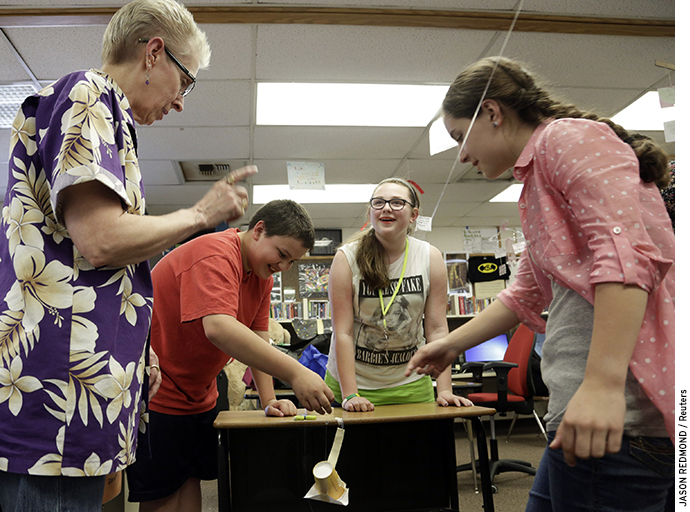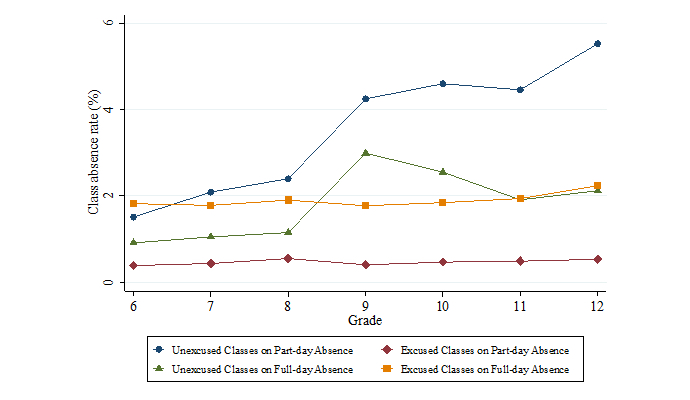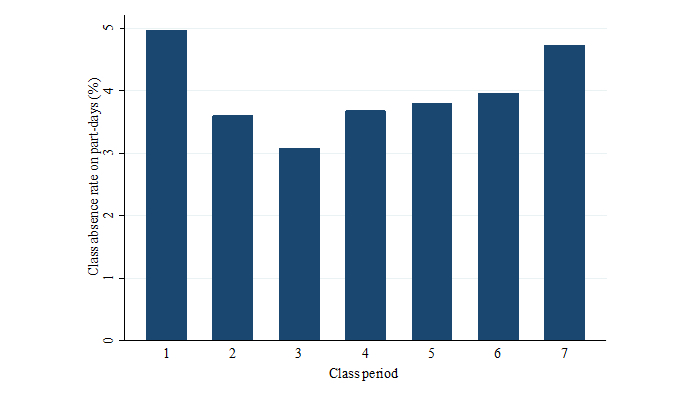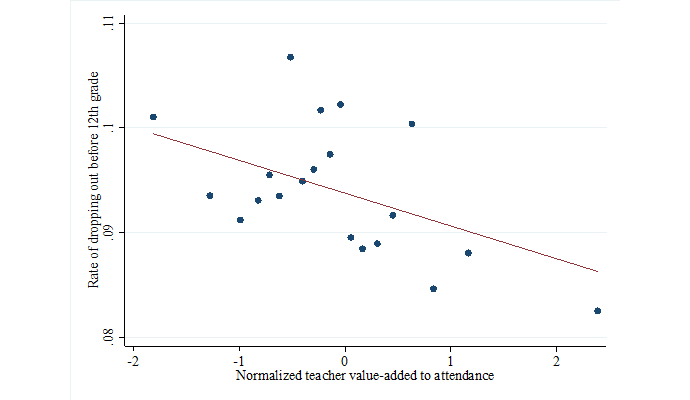
While just about all students miss school some days during their elementary and secondary years for occasional sickness and family needs, some students miss school far more often. One conservative estimate is that 10 percent of students miss at least 10 percent of school days each year.[i] On top of being counted as absent for the full day, many students skip classes even when they are officially in school. In fact, students are as likely to miss a class because they simply choose to skip than they are to miss because they are out for the day.[ii] As shown in Figure 1, students’ unexcused class absence rate, on days they attend at some point, doubles once they enter high school (at least in this urban school district). Moreover, unexcused class absences on days when students are in school explains almost all of the increase in total absences in high school.
Figure 1: Mean absence rates by grade

Note: Years 2007-08 to 2012-13. Rates average across all student-year-semester-class observations in a given grade. Unexcused or excused classes on part-day absence is defined as percentage of unexcused or excused absences from a class on those days when students are part-day absent. Unexcused or excused classes on full-day absence is defined as percentage of unexcused or excused absences from a class on those days when students are full-day absent.
Source: Whitney, Camille R. & Liu, Jing (2016). “What we’re missing: A descriptive analysis of part-day absence in secondary school,” Working Paper.
Missing school and skipping class is consequential. Using variation in attendance caused by inclement weather, one study estimated that each additional absence reduced math achievement by 0.05 standard deviations, suggesting that attendance can account for up to one-fourth of the achievement gap by income.[iii] A similar study using data on students in Philadelphia found that living farther from school increased absences and resulted in lower grade point averages and test scores.[iv]
So why do students, especially high school students miss so many classes? Clearly multiple factors are in play. Students can face challenges simply getting to school as they may rely on public transportation, have family responsibilities in the morning, or simply have difficulty waking up. Missing first period is more common than missing other classes (about 5 percent, compared to about 3 percent for 3rd period, which is the lowest — see Figure 2), though missing the last period is almost as likely.[v] They may have friends who are not in school or the potential for jobs and the monetary benefits they bring.
Figure 2: Class absence rate by period (for one urban district)

Note: Includes only students in schools that have 6-8 total periods per day. Rates represent the percentage of class meetings on which student was marked absent that period, on days that student was marked tardy or present in at least one other class (i.e., part-days).
Source: Whitney, Camille R. & Liu, Jing (2016). “What we’re missing: A descriptive analysis of part-day absence in secondary school,” Working Paper.
School, in general, and specific classes, in particular, also can be unpleasant experiences for students. More than one in four (28 percent) U.S. students between the ages of 12 and 18 say they have been bullied at school.[vi] This bullying ranges from being made fun of to being threatened with harm to actual physical contact and it happens in classrooms as well as in hallways and bathrooms and locker rooms.[vii] It also has long-run negative consequences for students.[viii] Even without direct bullying, some classes can be painful experiences, with the work either far too easy or far too difficult or the instruction too tedious for engagement.
The great returns to education—and there are many, from earnings to health to civic engagement—are unlikely to compensate for poor day-to-day experiences for students. For quite a while we have known that teenagers discount the future far more than do older adults, or even young adults.[ix] That is, many teenagers are not willing to sacrifice their enjoyment of life today for future benefits. Part of schools providing high quality educational opportunities, is providing engaging classrooms that are enjoyable so that teens don’t have to make a tradeoff for future gains.
Schools can do this. Recent research shows that both schools and individual teachers can affect attendance. As one example, a number of anti-bullying programs have reduced student victimization in schools,[x] improving experiences for students. More generally, two recent working papers show that high school teachers vary considerably in how much they engage students and that these differences are seen both in the year the student is in the teachers’ class and for future years as well.[xi]
Kirabo Jackson’s research (2016) shows that 9th grade teachers vary in how much they help their students improve behaviors as measured by a combination of grades, on-time grade progression, suspensions and full-day absences. In our own work, we distinguish teachers’ effects specifically on students’ daily, unexcused absences in the teachers’ classes. The benefits of measuring teachers’ effects on class absences instead of on a combination of full-day absences and other measures such as grade progression are both that class absences can be linked to a particular teacher where as full-day absences are likely affected by multiple teachers, and because the additional measures, such on-time grade progression, are affected by both academic achievement and engagement. By assessing teachers’ effects on class skipping, we more directly target student engagement. We also find meaningful variation across teachers.
Some teachers are far abler to engage students in class than others are. Moreover, these are consistent abilities for teachers. If a teacher is effective at engaging students in one year, he or she is likely to be good at engaging students in the next year and in the following years as well. In fact, teacher effectiveness at engagement (as measured by student class attendance) is at least as consistent across classes over time as teacher effectiveness at improving students’ math or English language arts skills.[xii]
Teachers that improve students’ test performance most are not necessarily the same teachers as those who improve students’ attendance. Effectiveness at test score improvement is positively correlated with effectiveness at attendance improvement. That is, on average, teachers who are better at one are slightly more likely to be better at the other, but the relationship is not strong. Many teachers who are good at improving achievement are not good at improving attendance and many teachers who are good at improving attendance are not good at improving achievement. Reaching students at risk of chronic absenteeism likely takes skills that not all teachers have or require behaviors that not all teachers have been willing to undertake. We don’t currently know what those skills or behaviors are.
These teacher effects on attendance have long-lasting, important consequences for students. Both our study and Jackson’s find that having more engaging teachers increases not only attendance in the year in which the student has the teacher but also improves students’ chances of completing high school (See Figure 3). Both studies find that engaging teachers are approximately as influential on high school completion as teachers who are highly effective at improving students’ test performance. We find that English teachers, in particular, greatly affect students’ educational attainment, both through their effects on student test performance and their effects on student engagement.
Figure 3: High school dropout rate as a function of average teacher value-added to attendances in grades 7-9

Note: Data come from all 7th to 9th graders during school years 2002-03 through 2012-13 in the district we examine. We pool together all math and ELA classrooms. To construct this binned scatter graph, we first residualize dropping out rate using baseline student, class, and school level characteristics, which include lagged math and English scores, absence rates, suspension, and demographic composition; tests students took in both previous and current year interacted with grade; year fixed effects; and subject fixed effects. We also control for teachers’ value-added to achievement so that we are holding teachers’ capability of increasing test scores constant. Finally, we add back the unconditional mean of the y variable to facilitate interpretation.
Source: Liu, Jing & Loeb, Susanna (2016). “Engaging Teachers: Measuring the Impact of Teachers on Student Attendance in Secondary School,” Working paper.
Should we care about keeping students in school and in class? Yes. Even holding constant test performance, students with a high school degree are far better positioned for economic success than those without. The Bureau of Labor Statistics reports that the median weekly earnings of high school degree holders (with no more advanced education) is $678 compared to $493 for those without, while the relevant unemployment rates are 5.4 percent compared to 8.0 percent.[xiii] Moreover, recent research provides evidence that the returns to degrees has gone up relative to returns to skills.[xiv] In fact, this research finds that holding test scores constant, the benefits of having a high school degree doubled from the 1980s to the 2000s.
Keeping students in school and in classes matter…and we have policy levers to do so. Preliminary evidence shows, for example, that low-cost interventions informing parents if their children are missing school can reduce chronic absenteeism.[xv] More broadly, if some teachers can engage students in their classrooms, then others can as well. The same types of policies and practices that have supported the development of measures of teaching practice that improve math or English language arts skills, could be used to develop similar measures focused more directly on student engagement. The same types of policies that have led to improvements in teaching math and English—such as regular feedback and a common language for good instruction[xvi]—could lead to improvement in engagement. Moreover, by including attendance as an indicator under the Every Student Succeeds Act, states could motivate these improvements. We should learn how to engage students and that knowledge should be used to help teachers improve and to select teachers who are most effective in this domain for the positions in which they are most needed.
—Susanna Loeb and Jing Liu
Susanna Loeb is the Barnett Family Professor of Education at Stanford University, faculty director of CEPA Labs, and a co-director of Policy Analysis for California Education. Jing Liu is a doctoral student in Economics of Education at the Stanford Graduate School of Education.
This post originally appeared as part of Evidence Speaks, a weekly series of reports and notes by a standing panel of researchers under the editorship of Russ Whitehurst.
Notes:
[i] Balfanz, R., & Byrnes, V. (2012). Chronic Absenteeism: Summarizing What We Know From Nationally Available Data. Baltimore: Johns Hopkins University Center for Social Organization of Schools.
[ii] Whitney, Camille R. & Liu, Jing (2016). “What we’re missing: A descriptive analysis of part-day absence in secondary school,” Working Paper; Cortes, K. E., Bricker, J., & Rohlfs, C. (2012). The Role of Specific Subjects in Education Production Functions: Evidence from Morning Classes in Chicago Public High Schools. The B.E. Journal of Economic Analysis & Policy 12(1). Retrieved from http://www.degruyter.com/view/j/bejeap.2012.12.issue-1/1935-1682.2749/1935-1682.2749.xml.
[iii] Goodman, Joshua (2014). “Flaking Out: Student Absences and Snow Days as Disruptions of Instructional Time” NBER Working Paper 20221.
[iv] Gottfried, M. A. (2010). Evaluating the Relationship Between Student Attendance and Achievement in Urban Elementary and Middle Schools: An Instrumental Variables Approach. American Educational Research Journal 47(2): 434–465.
[v] Whitney, Camille R. & Liu, Jing (2016).
[vi] U.S. Department of Justice, Bureau of Justice Statistics, School Crime Supplement (SCS) to the National Crime Victimization Survey (NCVS), 2011.
[viii] Eriksen, Tine Louise Mundbjerg, Nielsen, Helena Skyt & Simonsen, Marianne (2014). “Bullying in Elementary School.” Journal Human Resources 49(4): 839-871.
[ix] Green, Leonard, Myerson, Joel, & Ostaszeski, Pawel (1999). “Discounting of delayed rewards across the life span: age differences in individual discounting functions,” Behavioral Processes 46(1): 89–96.
[x] Ttofi, Maria M. & Farrington, David P. (2011). “Effectiveness of school-based programs to reduce bullying: a systematic and meta-analytic review.” Journal of Experimental Criminology 7(27).
[xi] Jackson, Kirabo (2016). “What Do Test Scores Miss? The Importance of Teacher Effects on Non-Test Score Outcomes.” NBER Working Paper 22226; Liu, Jing, & Loeb, Susanna (2016). “Engaging Teachers: Measuring the Impact of Teachers on Student Attendance in Secondary School,” Working paper.
[xii] Liu, Jing & Loeb, Susanna (2016).
[xiii] http://www.bls.gov/emp/ep_chart_001.htm. Data from the Current Population Survey updated March, 2016.
[xiv] Castex, Gonzalo & Dechter, Evgenia Kogan (2014). “The Changing Roles of Education and Ability in Wage Determination.” Journal of Labor Economics 32(4): 685-710.
[xv] See draft paper: Rogers, Todd & Feller, Avi (Draft). Intervening through Influential Third Parties: Reducing Student Absences at Scale through Parents.
[xvi] See Taylor, Eric S. and John H. Tyler. 2012. “The Effect of Evaluation on Teacher Performance.” American Economic Review 102(7): 3628-3651; Papay, John, Eric S. Taylor, John H. Tyler, and Mary Laski. “Learning Job Skills from Colleagues at Work: Evidence from a Field Experiment Using Teacher Performance Data.” July 2015.



